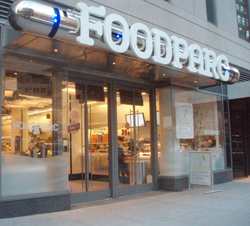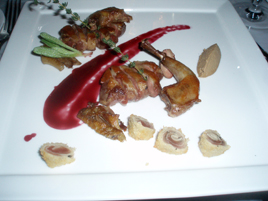Gastroarte
 Tuesday, October 25, 2011 at 12:43PM
Tuesday, October 25, 2011 at 12:43PM 
Note: Gastroarte “closed for renovations” in September 2012. The chef, Jesús Núñez, had already left the restaurant to open a similar place in the West Village called Barraca. The space, still under the same owners, and still Spanish, is now called Andanada 141.
*
 I wrote last week about the Spanish moment we’re in: Gastroarte, Salinas, Tertulia, and the extravagant Romera, all open within the last year, and all with ambitious—or in Romera’s case, stratospheric—intentions.
I wrote last week about the Spanish moment we’re in: Gastroarte, Salinas, Tertulia, and the extravagant Romera, all open within the last year, and all with ambitious—or in Romera’s case, stratospheric—intentions.
They probably won’t all succeed, but it’s progress in a town that has too many Italian and New Brooklyn restaurants, and not enough of practically everything else.
 Gastroarte opened in January 2011 as Graffit, named for the graffiti-clad walls and the chef Jesús Núñez’s artful platings. But a google search on Graffit most often returned another Manhattan restaurant, chef Jehangir Mehta’s Graffiti.
Gastroarte opened in January 2011 as Graffit, named for the graffiti-clad walls and the chef Jesús Núñez’s artful platings. But a google search on Graffit most often returned another Manhattan restaurant, chef Jehangir Mehta’s Graffiti.
Mehta sued for copyright infringement and Núñez relented, renaming his restaurant Gastroarte. Good move. Even if the suit was baseless (as it almost certainly was), it was dumb to have two such similar names in one city, and Mehta got there first.
It took some chutzpah to put such a restaurant on the Upper West Side, near Lincoln Center, a neighborhood not known for rewarding culinary risk-takers. Of course, the city’s restaurant critics aren’t known for that either. Sam Sifton, Adam Platt, and Steve Cuozzo all gave it just one star apiece.
 Those ratings aren’t irksome in themselves: I gave it 1½ stars early on, and frankly, I am not sure if I would have rounded up or down, had I been using a system without half-stars. What is irksome is the lack of respect for the chef’s art and the recognition of its potential, even if its execution, at first, was not consistently enjoyable.
Those ratings aren’t irksome in themselves: I gave it 1½ stars early on, and frankly, I am not sure if I would have rounded up or down, had I been using a system without half-stars. What is irksome is the lack of respect for the chef’s art and the recognition of its potential, even if its execution, at first, was not consistently enjoyable.
 Menu prices have risen: appetizers are now $14–21 (vs. $10–18 in January), entrées $29–32 (vs. $23–27). That’s a fairly substantial increase of around $8–10 per person (before dessert), in under a year. As before, a tapas menu is served only at the bar and at the front walk-in tables—an inexplicable blunder.
Menu prices have risen: appetizers are now $14–21 (vs. $10–18 in January), entrées $29–32 (vs. $23–27). That’s a fairly substantial increase of around $8–10 per person (before dessert), in under a year. As before, a tapas menu is served only at the bar and at the front walk-in tables—an inexplicable blunder.
I assume Gastroarte is getting the customers to justify those higher prices. Fortunately, it deserves them. Nine months later, Gastroarte is a much more polished restaurant. The service is more reliable, plates arrive at the right temperature, and the balance of flavors seems more sure-handed.
The vegetable stew under “Not-your-average egg” ($17; above left) changes with the season (compare it to the photo last time I had it). This version is less colorful than before, but it remains a triumph. As it was before, the centerpiece is an egg yolk enclosed somehow, miraculously, inside of a cauliflower sphere. It rests on turnip prepared two ways, and underneath that, yogurt and Serrano ham.


Lamb cheeks ($30; above left) were in a stew of lentils, spiced cheese, and asparagus, with a slice of brioche. A cuboid of black rice ($29; above right) was topped with calamari, sobrasada, and snow peas, with a streaks of Idiazábal cheese and red tobiko as garnishes.
 Núñez doesn’t splurge on ingredients, but the assembly of these dishes is impressive, and so are the flavors, which blend beautifully. Both of the central proteins, the lamb cheeks and the calamari, were just right.
Núñez doesn’t splurge on ingredients, but the assembly of these dishes is impressive, and so are the flavors, which blend beautifully. Both of the central proteins, the lamb cheeks and the calamari, were just right.
The difference from January is that the plates are no longer just entrants in an art exhibit: they’re a pleasure to eat, as well. That’s based on a small sample of the menu (plus amuses bouches and petits fours), but Gastroarte today seems far more promising than Graffit did at the beginning of the year.
Early on a Friday evening, before the opera, the dining room was not quite full. I have no idea if the traffic dies, or picks up, after curtain time; however, the restaurant has managed to impose a rather substantial price increase, without any of the usual signs of desperation, so I assume it is not doing badly.
In the competitive Lincoln Center dining market, it’s difficult to remain relevant (just ask Picholine, now an OpenTable 1,000-point fixture), but perhaps Graffit is on its way to becoming essential.
Gastroarte (141 W. 69th St. between Broadway & Columbus Ave., Upper West Side)
Food: **
Service: **
Ambiance: **
Overall: **




























































